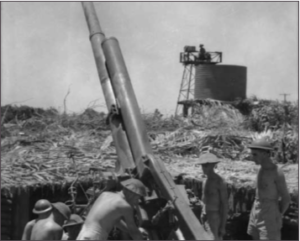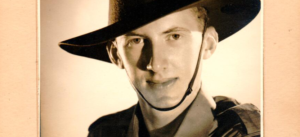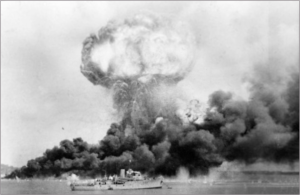My first day in the Army was 7th January 1942 when at the ripe age of eighteen I fronted up to enlist. I was delighted to find that an old school acquaintance, Stan Burrows, was also enlisting. We went to George’s Heights, where after two days of elementary drill exercises, volunteers were called for to man special equipment on islands north of Australia. Stan and I stepped forward, thus joining a very secretive new unit called RDF – Radio Direction Finder. After a few lectures we were taken to Beacon Hill to see a machine operating which could pick up a rowing boat well out to sea providing it had steel rowlocks. Then, incredibly, one week after joining the Army, we were sent on three days leave before heading north. The journey to Darwin took ten days on train, trucks and cattle trucks, and we arrived during a violent storm on February 1st.
On Thursday 19th February Stan and I were on the parade ground at 0955 hours when all hell broke loose. Bombs were falling all around. Wave after wave of bombers passed overhead and fighters streaked across at roof top level, the zero pilots clearly visible, looking down upon us, grinning. They were having a ball because there was no resistance; they had it to themselves and they just weaved around and did what they wanted. All senses were overwhelmed by the destruction that followed. As the attack ended many ships in the harbour were sunk or burning. The town was a shambles and a great pall of smoke hung over the scene. After the noise of aircraft, bombs and anti-aircraft fire, the silence was rather eerie. We were employed righting overturned trucks and clearing debris until 1210 hours when more waves of bombers came over, this time concentrating on the airfield. We learnt later that the attackers were 188 aircraft from a Japanese Naval Taskforce: the same taskforce that attacked Pearl Harbour.
I was stunned. I knew I was watching history unfold in front of me – this was the first time mainland Australia was being attacked by a foreign power. Our unit was split up between the various gun sites and Stan and I went to 14th H.A.A. Battery No 1 detachment of 4×3.7” anti-aircraft guns, located on Darwin Oval on the cliffs. We were now gunners on the first site to engage the Japs, and we had to learn in a hurry. The scene from the cliff after the initial raids was dreadful: behind us, masses of thick black smoke and on the harbour all ships in sight burning, sinking. The water was thick with black oil and littered with small boats, bodies and debris. Soon after the first raid, when all seemed quiet, there occurred the most awesome explosion that I have ever heard. The Neptuna, a ship at the wharf loaded with ammunition including depth charges, previously hit and burning, blew up. Great sections of the ship were scattered over a wide area and a huge column of smoke shot skywards. All civilians and other Army units were moved south off the peninsula leaving we few to defend Darwin.
With nothing but emergency rations we had to scrounge for food. In the event of invasion our orders were to fight for as long as able, then to spike our guns, and then every man for himself.
Stan and I were later sent to the 22nd anti-aircraft unit, which brought about a complete change in our war and way of life. This new unit’s mobile guns were usually out in the bush protecting airstrips. These positions entailed total isolation in very primitive conditions with strict water rationing (one kerosene tin per person for all uses), maggot infested food, endemic dysentery and tropical ulcers that ate into your legs. The mobile guns had to be dug into the ground with pick and shovel and moved frequently. 62 further air raids occurred over the Darwin area in 1942/43. My war was not glamorous, far from it. In fact I cannot think of any period in those years on which I can look back with pleasure. However there was comradeship; it forged a lifelong friendship with Stan Burrows. One learns of the inner strength that can be drawn upon in difficult circumstances and it has given me an appreciation of how wonderful life is.
After the war I had the most remarkable luck in meeting my wife Gwen. We had four children and a wonderful life together. We’ve been here for 15 years now and I am involved with the War Museum as its Acquisitions Officer. We love living here. We have our friends, our family, our garden, and each other to be thankful for.



Author – Helen Johnston
Continue Reading
Discover our Services
Home Care
Retirement Living
Residential Care
Veteran Services
Download a brochure
We'll never share your email address and you can opt out at any time, we promise


